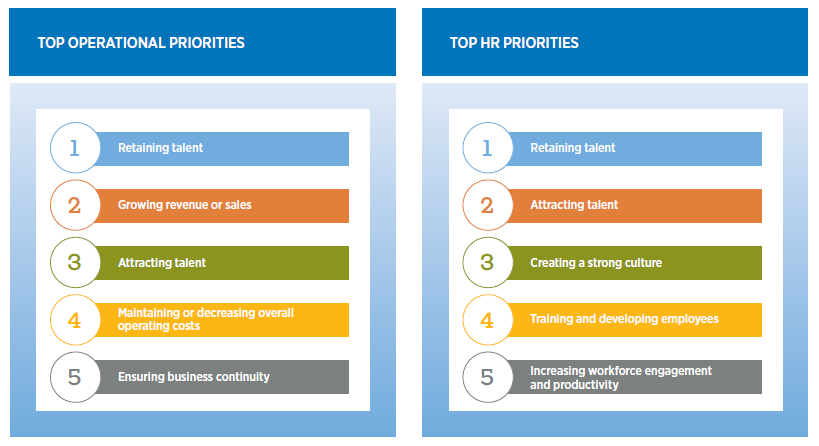Goldman Sachs denies rumors of hiring freeze, what’s zapping employee digital productivity and more
Plus: How HR’s priorities stack up against business operations and your weekly dose of inspiration.

Hi there, comms connoisseurs.
Let’s explore some notable stories from July 18-22, 2022 — and pull out a few timely, tactical takeaways along the way:
- Goldman Sachs CEO denies rumors of hiring freeze amid economic slowdown
Goldman Sachs CEO David Solomon said that the investment bank is slowing, but not freezing, its hiring efforts, despite its efforts to cut costs and prepare for a looming recession.
“There is no hiring freeze at Goldman,” Solomon said on Yahoo Finance Live at Goldman’s 10,000 Small Businesses Summit on Tuesday. “We’re looking at all our resources around the firm, financial and otherwise, and we are slowing the pace of our hiring. So we’ve grown the firm enormously over the course of the last few years. We’ve done a significant amount of hiring. We had planned to do meaningful hiring in the back half of the year. And we’re slowing it down. But we haven’t frozen it.”
Earlier in the week, Goldman chief economist Jan Hatzius broke down the company’s grim economic forecast in a separate conversation with Yahoo:
“We continue to expect that the slowing economy will lead job growth to fall sharply to 150k/month in 2022H2 and to 60k/month in 2023, causing the unemployment rate to gradually rise to 3.8% at end-2023 and 4.0% at end-2024,” Goldman Chief Economist Jan Hatzius said. “We see risks around this forecast as two-sided, reflecting elevated risk of a recession that would cause greater labor market damage, but also the possibility that very high labor demand might limit labor market deterioration.”
“Signs of the slowing economy should show up in payroll employment soon, however, since job growth typically tracks economic activity very closely and statistical estimates imply a front-loaded employment drag,” Goldman’s Hatzius added. “Slower activity already appears to be weighing on hiring to some extent, since employment growth slowed more in states where spending softened in May.”
Solomon’s assurances and Hatzius’ projections demonstrate how your organization’s experts and leaders can both speak to the same message about internal developments from a different perch. In this case, Hatzius’ forecast doubles as a precedent that the organization can use to justify any future changes to its hiring practices through the context of the larger economic climate, while Solomon’s words offer a balm for the present moment. Each subsequent message should acknowledge the previous messages that came before it, and also set the expectation that the leader speaking will keep stakeholders updated as things change.
Employee communicators should be intimately aware of how various messages from its leaders not only frame its business operations to external stakeholders, but to employees first and foremost. It’s unclear when and how this message of a hiring slowdown was communicated internally, which is why many organizations publish statements as internal memos shared exclusively with a publication of their choice for a mixternal degree of transparency.
Ultimately, treating employees as your most important customers can guide the consistency of your internal communications, and the order that you share them—in this case, softening the intensity of any grim economic forecasts with a pragmatic message to employees that explains what it means for them.
- Outdated meeting tech is zapping employee productivity
New research from communication platform Loom found that employee productivity can be greatly impacted by tech functionality, as audio/video quality, software and connection issues add up to lost time during the work week. Nearly half (47%) of respondents said that they overthink messages they send, while 20% said that misunderstanding or miscommunication around digital messages has caused them to be reprimanded, demoted or fired. The study also found that workers spend an average of on hour and 42 minutes scheduling and rescheduling phone calls each week.
“Regardless of where people work, the reliance on old tech in addition to adjusting to new tools is sapping focus time. Despite the influx of new solutions, employees report they continue to spend much of their time in meetings and are frustrated with traditional comms tools — channels like email, phone calls, video conferencing and more.”
These numbers make a profound case for comms owning the digital transformation strategy at each organization. By crafting fresh guidelines for productive and efficient communication with each new tool or software you add to your tech stack, you can encourage employees across all business functions to hold themselves accountable for the efficiency, productivity and effectiveness of their communications.
Check out the full study here.
- How upskilling and talent recruitment stack up as business priorities
A new study from Gallagher offers insights into how recent workforce trends intersect with evolving organizational strategies. In one example, the study compares top operational priorities to top HR priorities. Retaining talent is considered a top priority in both lists, but HR considers attracting talent its second-highest priority while that priority ranks third as an operational function—behind growing revenue or sales:

This discrepancy highlights how attracting and retaining talent are essential to business operations — and how attracting the right people to your organization can be framed around bottom-line considerations like revenue to encourage buy-in for your employer branding efforts across business functions. You can also position these needs around talent and upskilling around other operational priorities — like reducing operating costs and ensuring business continuity — by demonstrating how they contribute to employee loyalty, belonging and productivity.
Read the rest of the study here
- How about some good news?
This week, let’s draw inspiration from:
- A newly discovered radio frequency from a distant galaxy that sounds like a heartbeat
- Biodegradable baby shoes that reduce landfill waste
- The elusive Sato’s beaked whale being photographed for the first time
- Ragan Training, which is an incredible resource for communication inspiration and education.
- You also deserve an award. Get your due here!
Take good care of yourselves, comms champion, and keep up the good work.







